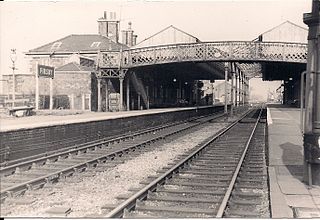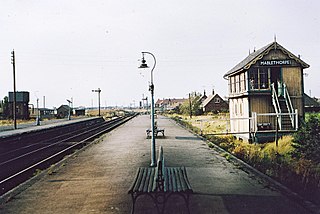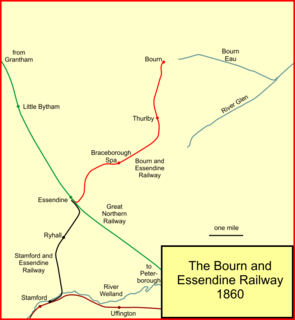
The Great Northern Railway (GNR) was a British railway company incorporated in 1846 with the object of building a line from London to York. It quickly saw that seizing control of territory was key to development, and it acquired, or took leases of, many local railways, whether actually built or not. In so doing, it overextended itself financially.
The Derbyshire and Staffordshire extension of the Great Northern Railway was an English railway network built by the GNR to get access to coal resources in the area to the north and west of Nottingham. The Midland Railway had obstructed the GNR in its attempts to secure a share of the lucrative business of transporting coal from the area, and in frustration the GNR built the line. The line was forked: it reached Pinxton in 1875 and a junction with the North Staffordshire Railway at Egginton, approaching Burton on Trent in 1878. The line cut through Derby, resulting in considerable demolition of housing there.

Firsby is a small rural linear village and civil parish in the East Lindsey district of Lincolnshire, England. It is situated 30 miles (48 km) east from the city and county town of Lincoln, 4 miles (6.4 km) south-east from the nearest market town of Spilsby, and 7 miles (11 km) inland from the holiday resort town of Skegness.

The West Riding and Grimsby Railway was a railway company that promoted a line between Wakefield and Doncaster, in Yorkshire, England. There was also a branch line connection from Adwick le Street to Stainforth, which gave access towards Grimsby. The company was promoted independently, but it was sponsored by the Manchester, Sheffield and Lincolnshire Railway and the Great Northern Railway, and became jointly owned by them.

Spilsby railway station was a railway station in the market town of Spilsby, Lincolnshire, England. The station stood on a four mile long branch line between Spilsby and Firsby Junction, where it connected with the main line from Cleethorpes to London, and was opened on 1 May 1868. However, traffic on the line soon slumped, and the line was bought by the Great Northern Railway in 1890. In 1939 passenger services on the line were suspended, leaving only a goods service which itself ceased in 1958, when the railway station and line were closed.

Firsby railway station was a station in Firsby, Lincolnshire. It served as a main line station and a terminus for two branch lines to Skegness and Spilsby respectively. The station was popular in the 19th and early 20th centuries for seaside connections to Skegness, but was recommended for closure in the Beeching Report and closed in 1970. The station was mostly demolished.

Halton Holegate railway station is a former station in Halton Holegate, Lincolnshire. It was on a short branch from Firsby to Spilsby.
The Ambergate, Nottingham and Boston and Eastern Junction Railway was a British railway company, which hoped to connect Lancashire with the port of Boston, in Lincolnshire. It was authorised in 1846 but was unable to raise much money. It opened a standard gauge line from a junction near Nottingham to Grantham in 1853. At Nottingham it was to rely on the Midland Railway, but that company was hostile and obstructive.

The East Lincolnshire Railway was a main line railway linking the towns of Boston, Louth and Grimsby in Lincolnshire, England. It opened in 1848. The ELR Company had leased the line to the Great Northern Railway, and it was the latter which constructed the line and operated it, as its East Lincolnshire Line.
The Kirkstead and Little Steeping Railway, locally known as the New Line, was a railway line in England built to shorten the route between Lincoln and Firsby in Lincolnshire, England.

The Louth to Bardney Line was an English railway line built by the Louth and Lincoln Railway Company, in Lincolnshire, England. It opened in stages between 1874 and 1876, after serious difficulties in raising subscription capital, and following alteration to the planned route. It was hoped to serve large reserves of ironstone along its route, but the deposits were not as large as hoped, and the line was never financially successful.

The Bourne and Sleaford Railway was promoted as a branch of the Great Northern Railway to fend off an expected incursion by the rival Great Eastern Railway. It was authorised by Parliament in 1865, but not opened until 1871 and 1872. Although agricultural traffic provided healthy business, the rural character of the line never produced much passenger trade, and it was closed to passengers in 1930. The line was severed and ceased to be a through line in 1956 and closed completely in 1965.
The Boston, Sleaford and Midland Counties Railway opened a railway line between Grantham and Boston, through Sleaford, England. It opened in two stages, in 1857 and 1859.
The Firsby to Skegness railway line is a branch railway line, in Lincolnshire, England. It was built by an independent company to connect Wainfleet, at first, and then the seaside town of Skegness, with the main line network at Firsby. It opened in 1871 from Firsby to Wainfleet, and 1873 throughout.

The Mablethorpe Loop railway was formed in Lincolnshire, England, by two independent railway companies, which built branches from the East Lincolnshire Line.
The Grantham and Lincoln railway line was a line in Lincolnshire, built by the Great Northern Railway to shorten the distance between those two places. It had already formed a network in Lincolnshire, but the route from London and points south and west of Grantham was very indirect.

The Bourn and Essendine Railway was promoted locally to give the small town of Bourn a railway connection to London over the nearby Great Northern Railway. The line was opened in 1860; it was a single line of seven miles length, and its route was in Lincolnshire and Rutland, England. There was talk of forming a through line with the Stamford and Essendine Railway, which was also at Essendine station, but on the other side of the main line, and this direct connection never took place. The Bourn and Essendine Railway was the first railway to reach Bourn, which later became a local focal point for single-track railways. The company never made money and sold itself to the GNR in 1864.
The Lincolnshire lines of the Great Northern Railway are the railways, past and present, in the English county built or operated by the Great Northern Railway.

The Bradford, Wakefield and Leeds Railway was an independent railway company that built a line between Wakefield and a junction close to Leeds, in Yorkshire, England. It opened its main line in 1857, and was worked by the Great Northern Railway. The line shortened the GNR route to Leeds.
The Leen Valley lines of the Great Northern Railway were railway branch lines built to access the collieries in the Nottinghamshire coalfield in England. The Midland Railway had long been dominant in the area, but there was resentment against its monopolistic policies from coalowners, who encouraged the Great Northern Railway to build a line. The Leen Valley Line was opened in 1881; it ran as far as Annesley colliery. A passenger service was run the following year, and very considerable volumes of coal were hauled.













